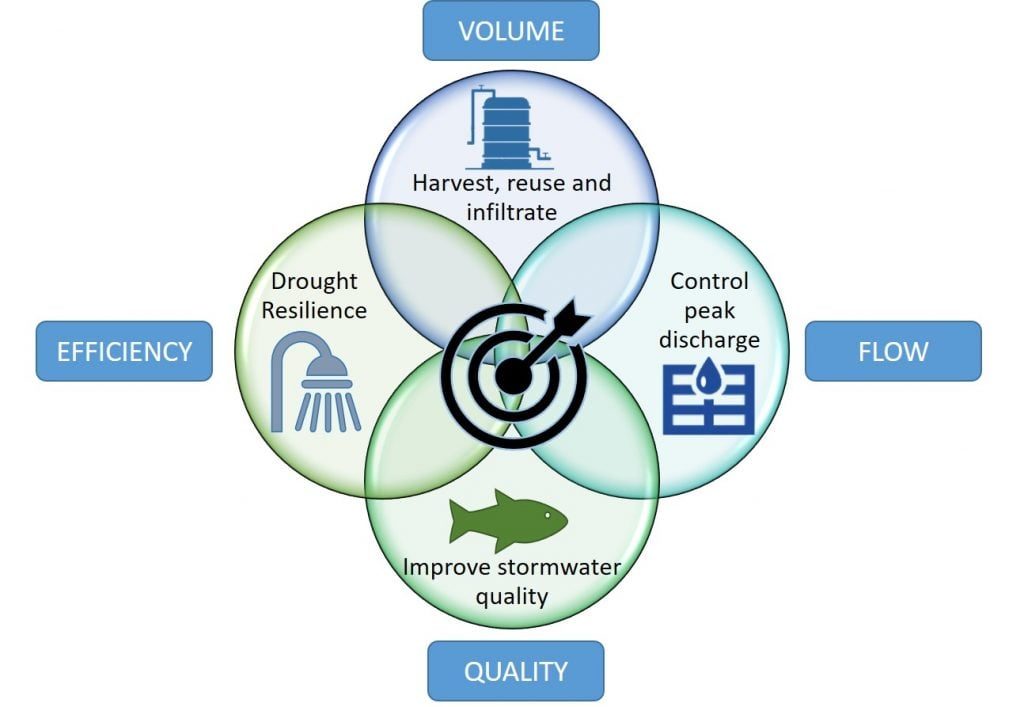Stormwater management self-certification for small-scale development
Incorporation of water sensitive urban design (WSUD) is required to be considered in all new urban developments. The InSite Water Tool (the Tool) provides an efficient and technically robust method to demonstrate whether the design features of small-scale developments have met performance criteria for:
- water conservation and efficiency
- stormwater runoff quality discharged to waterways and marine environments via Councils drainage system.
- stormwater runoff volume
- stormwater runoff flow rates.
This tool makes it easier to design a stormwater management strategy to meet development plan policy, and Building Code of Australia (SA) and Council engineering requirements in an integrated manner, including the South Australia Water Sensitive Urban Design Policy (Department of Environment, Water and Natural Resources, 2013).
To ensure that developments meet WSUD performance benchmarks, several best practice and management guidelines have been adopted.
Download relevant guidelines and resources
- WSUD 01 – A guide for water sensitive urban design: Stormwater management for small-scale development
- WSUD 02 – Residential development –deemed-to-satisfy solutions for stormwater management
- WSUD 03 – Residential development – compliance with the InSite Water Tool
- WSUD 04 – Commercial development – compliance with the InSite Water Tool
- WSUD 05 – Conceptual drawings of standard WSUD treatments for small-scale development
- WSUD 06 – InSite Water Tool: User manual
Our Approach
Urban stormwater design has traditionally focused on peak flows and pipe conveyance. Design standards have evolved and now require stormwater design to consider catchment changes created by urbanisation. Engineers Australia[1] now recommends the design and installation of volume management facilities as part of drainage design.
Stormwater design also needs to look after the needs of the site, the surrounding catchment infrastructure, and the receiving waterways. Water Sensitive Urban Design (WSUD) promotes the sustainable use and re-use of water in urban planning and buildings. This type of design integrates the water from all sources – including rainwater, stormwater, groundwater, mains water and waste water – into urban development and building design. WSUD measures and tools can be applied to residential, commercial and industrial developments and buildings. They include the storage, infiltration into the ground, treatment or use of stormwater runoff. Capture and use of stormwater run-off in urban areas has many social, economic and environmental benefits including:
- Saving money and reducing potable water use where rainwater is applied to fit-for-purpose practices, such as in toilets, hot water, laundry washing and garden irrigation.
- Creating greener and cooler urban environments with high visual amenity.
- Reducing flood risk and damage.
- Extending the useful life of existing Council stormwater infrastructure.
Developments must incorporate the following volume management objectives. These principles, and their respective design responses, must be targeted when considering the stormwater design options for a site.
The InSite Water Tool assists you to optimise your solution to meet the four design objectives for stormwater management.
[1] Adapted from Australian Rainfall and Runoff Guide – ARR 2019, Engineers Australia 2019 See Book 9 – Runoff in Urban Areas
Further Guidance
Water sensitive urban design : basic procedures for ‘source control’ of stormwater : a handbook for Australian practice / principal contributors, Martin D. Allen … [et al.] ; editor, John R. Argue.
- Available from the Centre for Water Management & Reuse, University of South Australia
Use of WSUD ‘source control’ practices to manage floodwaters in urbanising landscapes: developed and ultra-developed catchments Authors: John R Argue and David Pezzaniti, Centre for Water Management & Reuse, University of South Australia
- Available from Clearwater Victoria
WSUD Engineering Procedures Stormwater Stormwater eBook by Melbourne Water
- Available on the Amazon.com.au Kindle Store
Other online resources
Water Sensitive SA resources page
South Australian Water sensitive urban design – Greater Adelaide Region: technical manual
2019 Australian Rainfall and Runoff guidelines (ARR 2019)

